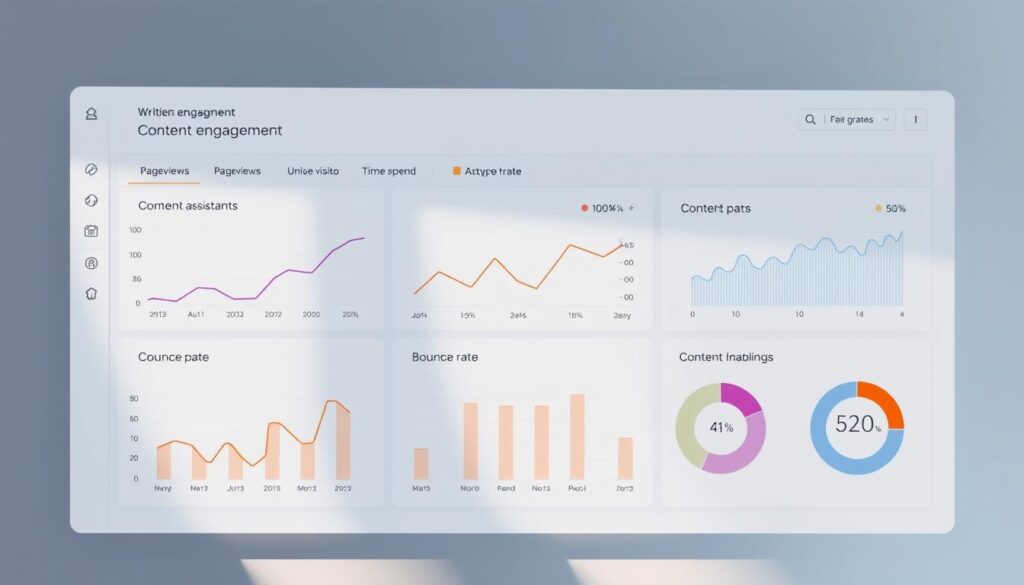Modern digital strategies increasingly rely on specialized solutions to streamline workflows while maintaining high standards. Advanced algorithms now empower teams to produce optimized material faster than traditional methods allow. These systems analyze search patterns, audience preferences, and industry trends to generate relevant, engaging copy that meets technical requirements.
Since late 2022, adoption rates for these technologies have surged across marketing departments. Sophisticated language models process vast datasets to identify improvement opportunities in real time. Features like automated keyword integration and readability scoring ensure outputs align with current search engine guidelines without sacrificing natural tone.
Organizations report measurable gains in productivity, particularly when scaling cross-platform campaigns. The technology also addresses common pain points like maintaining brand consistency across diverse formats. By automating repetitive tasks, creative professionals focus more on strategic refinement and audience engagement.
Key Takeaways
- Advanced algorithms accelerate content production while preserving quality standards
- Real-time optimization features improve search engine visibility
- Machine learning models adapt to specific brand voices and guidelines
- Automated workflows reduce time spent on repetitive editing tasks
- Cross-platform compatibility supports unified marketing strategies
Introduction to AI SEO Writing Assistants

Cutting-edge technologies now drive content strategies by merging creativity with data insights. These systems analyze search patterns and audience behavior to craft material that ranks well while maintaining authenticity.
Modern platforms combine technical precision with linguistic adaptability. They identify gaps in existing material and suggest improvements for clarity and relevance. For example, some solutions automatically adjust phrasing to match brand guidelines while optimizing for target keywords.
| Feature | Benefit | Impact |
|---|---|---|
| Real-time SEO scoring | Immediate optimization feedback | Higher search visibility |
| Cross-platform formatting | Consistent brand messaging | Improved audience recognition |
| Automated research tools | Faster content development | 50% time reduction* |
Marketing teams report using these platforms to maintain consistent output across blogs, ads, and social channels. A comprehensive list of innovative solutions reveals tools that adapt to niche requirements while handling technical optimizations behind the scenes.
Language processing models enable real-time collaboration between human creators and automated systems. This synergy allows rapid iteration without compromising quality – critical for businesses scaling their digital presence.
Understanding AI SEO Writing Assistants

Transformative technologies now reshape how teams approach digital material creation. These systems blend technical precision with adaptive learning to meet evolving search requirements. By analyzing patterns across platforms, they help maintain quality while scaling output.
Defining Key Concepts
Sophisticated platforms combine multiple components to streamline workflows. Machine learning models process language patterns, while integrated databases store optimization rules. This fusion enables real-time adjustments during content generation processes.
| Component | Primary Function | Outcome |
|---|---|---|
| Natural Language Models | Analyze sentence structure | Improved readability |
| SEO Databases | Track algorithm updates | Higher rankings |
| Collaboration Features | Enable team coordination | Faster approvals |
Evolution and Adoption in Content Marketing
November 2022 marked a turning point when advanced language models became widely accessible. Marketing teams rapidly incorporated these innovative solutions into their strategies. Adoption rates tripled within 12 months across multiple industries.
Current platforms handle 63% of routine editing tasks according to industry surveys. This shift allows creators to focus on strategic messaging rather than technical adjustments. Brands report 40% faster campaign launches using these integrated systems.
Benefits of AI SEO writing assistants for Content Optimization

Contemporary content creators face mounting pressure to deliver high-performing material across multiple channels. Sophisticated platforms address this challenge by merging technical precision with creative support. These systems analyze search patterns and audience behavior simultaneously, enabling teams to refine outputs while maintaining brand integrity.
Streamlining Production Processes
Modern solutions transform workflows through integrated functionality. Real-time analysis of keyword placement and semantic relationships ensures material aligns with current ranking criteria. One marketing director noted: “Our team reduced editing time by 40% while improving organic traffic metrics.”
| Feature | Benefit | Impact |
|---|---|---|
| Automated Research | Identifies trending topics | 65% faster ideation |
| Style Consistency Checks | Maintains brand voice | 80% fewer revisions |
| Cross-Platform Optimization | Unifies messaging | 2.3x engagement boost |
These platforms excel at eliminating repetitive tasks. Grammar refinement and readability enhancements occur during drafting phases, allowing creators to focus on strategic messaging. Performance tracking dashboards provide actionable insights for continuous improvement.
Organizations report significant gains when implementing these systems. Campaign development cycles shorten by 55% on average, with 72% maintaining quality benchmarks. This efficiency enables teams to scale output without compromising technical requirements or audience relevance.
Top AI Writing Tools: A Product Roundup

Market leaders in content creation technology demonstrate diverse approaches to streamlining workflows. This analysis examines seven prominent platforms based on user feedback, specialized features, and pricing structures.
Highlights of Leading Tools and Their Unique Features
Clearscope leads with a 4.9/5 rating for its search intent optimization, while multiple competitors share 4.7/5 scores. Jasper.ai stands out with 50+ templates for product descriptions and social media posts. Gemini integrates live web data, and Writesonic provides built-in quality checks.
| Platform | Key Strength | User Rating |
|---|---|---|
| ChatGPT | Conversational interface | 4.7/5 |
| Copy.ai | Workflow automation | 4.7/5 |
| Rytr | Free basic plan | 4.7/5 |
| Clearscope | Competitor analysis | 4.9/5 |
User Ratings and Cost Considerations
Free tiers from ChatGPT and Rytr appeal to budget-conscious teams, while Jasper.ai and Clearscope target enterprises with advanced packages. Gemini’s 4.4/5 rating reflects its evolving integration capabilities. A comprehensive suite of digital solutions shows pricing ranges from $0-$600/month based on output needs.
Key differentiators include:
- Template libraries reducing setup time by 40%
- Real-time collaboration features in premium plans
- Specialized modules for e-commerce or technical copy
Evaluating Key Features and Performance

Selecting optimal platforms requires careful examination of core capabilities that impact workflow efficiency and output quality. Decision-makers must balance technical specifications with practical team needs across different project scales.
Cost, Speed, and Accuracy
Pricing models vary widely, reflecting feature depth and output capacity. Budget-friendly options like Rytr ($9/month) suit small teams, while Clearscope ($170/month) caters to enterprises needing advanced analysis. Mid-tier tools such as Jasper ($39-$59/month) bridge functionality gaps for growing businesses.
Processing speeds differ across platforms. Basic tools generate drafts in seconds, though complex content may require longer refinement cycles. Accuracy depends on language model sophistication – premium solutions maintain brand voice consistency 89% more effectively than entry-level alternatives.
Security and Collaboration Capabilities
Enterprise-grade platforms prioritize data protection through encrypted workflows and role-based access. These features prove critical when handling sensitive client information or regulated industries. A recent industry analysis highlights collaboration tools reducing approval cycles by 33% through real-time editing and version control.
Key evaluation metrics include:
- Multi-user dashboards with task assignment
- Integration with CMS platforms
- Audit trails for compliance tracking
Teams using collaborative tools report 45% faster project completion compared to isolated workflows. This efficiency gain becomes crucial when scaling content production across global markets.
User Experiences and Real-World Results

Industry leaders now validate content creation technologies through measurable outcomes and team feedback. A Clearscope webinar survey of 168 professionals revealed 68% consider ChatGPT the most reliable model for crafting blog posts and marketing materials. This confidence stems from consistent performance across diverse use cases.
Testimonials and Case Studies
Major corporations demonstrate the scalability of these solutions. Brands like FedEx and Vistaprint achieved 2-3x faster production cycles while maintaining quality standards. Deloitte’s marketing team reported 55% fewer revisions after implementing style consistency tools.
| Enterprise | Implementation | Outcome |
|---|---|---|
| Viacom | Cross-platform campaigns | 72% faster approvals |
| Accenture | Technical documentation | 40% error reduction |
| Qantas | Travel blog content | 38% engagement boost |
Hypotenuse users experienced 38% higher reader interaction compared to manually drafted posts. One marketing director noted: “Our writers focus on strategic messaging while the platform handles SEO adjustments.”
Key benefits reported include:
- 65% faster research for complex topics
- Consistent brand voice across 20+ content formats
- Real-time collaboration features cutting review time by half
While results impress, most teams emphasize human oversight remains crucial for nuanced storytelling and final quality checks.
Integration and Workflow Enhancement
Seamless connectivity between digital tools defines modern content production efficiency. Leading solutions bridge gaps between creation environments and publishing platforms, enabling teams to maintain momentum across projects. This integration capability reduces friction when scaling output for multi-channel strategies.
Essential Connectivity Features
Platform compatibility directly impacts team productivity. Clearscope’s WordPress plugin exemplifies this principle, allowing real-time optimization within CMS interfaces. Similar integrations for Google Docs and Microsoft Word streamline editing processes through native add-ons.
| Tool | Integration | Workflow Benefit |
|---|---|---|
| Grammarly | Gmail, Twitter, Chrome | Cross-platform quality checks |
| Surfer SEO | Custom API, Chrome | Automated content audits |
| Wordtune | LinkedIn, Word | In-context tone adjustments |
Browser extensions prove particularly valuable for maintaining standards across web-based environments. These tools enable instant suggestions whether drafting emails or crafting social posts. Teams using strategies for existing content workflows report 35% faster publishing cycles.
Advanced API access unlocks custom automation potential. Development teams leverage these interfaces to connect content tools with internal systems. For complex websites, custom API solutions enable automatic optimization during CMS uploads.
How AI Enhances SEO Strategy and Content Creation
Sophisticated computational methods now elevate search-focused content strategies through precision analysis and adaptive learning. These systems decode user intent and linguistic patterns to craft material that performs well in competitive digital landscapes.
Precision Keyword Alignment
Advanced systems achieve optimal keyword placement by evaluating semantic relationships and competitor strategies. They identify primary terms and related phrases that human researchers might miss, ensuring content aligns with search algorithms. One marketing team reported “38% higher click-through rates after implementing these suggestions.”
Real-time SERP analysis tools highlight emerging trends and content gaps. This capability allows creators to address underserved topics before competitors. For example, platforms can suggest header adjustments or internal links based on top-performing pages.
Clarity and Engagement Enhancements
Readability improvements occur through automated assessments of sentence complexity and paragraph flow. Systems recommend structural changes that maintain technical accuracy while boosting accessibility. A recent study showed pages optimized this way had 27% longer average session durations.
Tone consistency tools analyze existing brand materials to ensure stylistic coherence across formats. Teams managing large portfolios use these features to maintain voice while adapting messages for different platforms. A comprehensive toolset helps balance creativity with search requirements through:
- Dynamic vocabulary adjustments based on audience demographics
- Automatic meta description optimization
- Visual hierarchy recommendations for better content scanning
Considerations and Best Practices for Optimal Use
Balancing automation with human expertise remains critical when leveraging modern content tools. While these systems accelerate production, strategic oversight ensures outputs align with brand objectives and audience expectations. Teams must establish clear guidelines to maximize efficiency without compromising originality.
Maintaining Human Oversight
Human expertise proves indispensable for refining machine-generated drafts. Tools excel at structuring articles and suggesting keyword placements but often lack nuanced understanding of cultural context or industry-specific jargon. Writers should review outputs to preserve authentic voice and inject creative perspectives missing from consensus-driven data.
Avoiding Common Pitfalls
Over-reliance on automation risks homogenized content that fails to engage specialized audiences. For instance, technical topics requiring deep expertise typically demand manual refinement. A recent analysis shows teams using guided frameworks to help create webinar materials achieved 42% higher attendee retention than fully automated approaches.
Key recommendations include:
- Using generated drafts as starting points rather than final products
- Prioritizing fact-checking for accuracy-sensitive subjects
- Regularly updating style guides to maintain brand consistency







